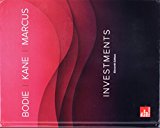
Call option:
It is an agreement where the buyer is entitled the right to buy a stock at a pre-specified price within a pre-specified period. The stock on which the call option is provided is called the underlying asset.
Put option:
It is an agreement where the buyer is entitled the right to sell a stock at a pre-specified price within a pre-specified period. The stock on which the put option is provided is called the underlying asset.
Put-call parity: The put call parity provides a relationship among the stock price, strike price, call price and the put price. According to this theory, the difference between the price of a call option and put option on the same asset underlined with the same strike price and expiry date equals to the difference between the stock price and the present value of the strike price.
To determine:
The impact of volatility on the option values and to provide a numerical example using put call parity relationship to support it.
Answer to Problem 1PS
More volatility on the option value, higher the value of the call option and put option. It was verified by the numerical example.
Explanation of Solution
The value of call option increases when the stock price increases while the value of put option increases when the stock price decreases. So, the value of call option and put option depends on the movement of the stock price or the underlying asset.
Volatility refers to the fluctuation in the level of market price of the underlying asset. So, volatility may cause the stock price to increase or decrease. So, with volatility, it is likely that stock price increases or decreases with time, which causes the value of call and put option to increase. Longer the time period to expire the option, greater is the volatility.
Let's take a numerical example to verify it. Consider two cases where volatility or expiration period is changed and other factors remain the same and then calculate the value of call option.
Case 1 Consider a stock with price $68.73. The value of put option is $2.50 and risk free rate is 8%. Both put and call option on this stock has a strike price is $75. For both, the expiration period is 1 year. Using the put call parity, the value of call option is calculated.
Given:
Stock price=$68.73
Strike price = $75
Price of put option= $2.50
Risk free rate=0.08
Time to expire= 1 year
Calculation:
Using put call parity equation,
Here, the price / value of call option is $3.
Case 2 Consider a stock with price $68.73. The value of put option is $2.50 and risk free rate is 8%. Both put and call option on this stock has a strike price is $75. For both, the expiration period is 5 year. Using the put call parity, the value of call option is calculated.
Given:
Stock price=$68.73
Strike price = $75
Price of put option= $2.50
Risk free rate=0.08
Time to expire= 5 year
Calculation:
Using put call parity equation,
Here, the price / value of call option is $20.96.
Longer the expiration period, greater is the volatility and higher the value of call option.
Want to see more full solutions like this?
Chapter 21 Solutions
Investments, 11th Edition (exclude Access Card)
- The decisions relating to the use of profits or income of an entity or organization are known a.Any of these b.Dividend decisions c.Finance decisions d.Investment Decisionarrow_forwardWhat are the three interrelated areas of finance? (a) Financial markets, option and forwards (b) Banking, financial institutions and swap currency (c) Investment, Financial management and Financial market & Financial institution (d) All of abovearrow_forwardThe method that converts the amount of present cash into an amount of cash of equivalent value in future is: a.Budgeting b.Both a and b c.Discounting method d.Compounding methodarrow_forward
- The government finance which includes the principles and practices relating to the Procurement and management of funds for Central Government, and Local bodies is known as: a.Public Finance b.All of these c.Private Finance d.Business Financearrow_forwardwhat is financial ratios?arrow_forwardWhich of the following is the activity which finance people are involved? (a) Investing decisions (b) Marketing decisions (c) Promotion decisions (d) Non of Abovearrow_forward
- You plan to invest $3,500 per year for 39 years into an IRA. What will the value of the IRA be after 39 years if the interest rate is 9% per year? Your answer may vary due to rounding.arrow_forwardIn finance, we refer to the market where new securities are bought and sold for the first time? (a) Money market (b) Capital market (c) Primary market (d) Secondary marketarrow_forward1: ________ is shown on a multiple-step but not on a single-step income statement. A. Credited to Inventory B. A customer utilizes a prompt payment incentive. C. Debited to the Inventory account D. Gross profitarrow_forward
- what is corporate finance? explain it.arrow_forwardA lorenz curve graphs the _________________ received by everyone up to a certain quintile. A. Unequal distribution over time B. Normative shares of income C. Cumulative shares of income D. Total share of incomearrow_forwardNeedhdjxjx ususs shsharrow_forward
 EBK CONTEMPORARY FINANCIAL MANAGEMENTFinanceISBN:9781337514835Author:MOYERPublisher:CENGAGE LEARNING - CONSIGNMENT
EBK CONTEMPORARY FINANCIAL MANAGEMENTFinanceISBN:9781337514835Author:MOYERPublisher:CENGAGE LEARNING - CONSIGNMENT Intermediate Financial Management (MindTap Course...FinanceISBN:9781337395083Author:Eugene F. Brigham, Phillip R. DavesPublisher:Cengage Learning
Intermediate Financial Management (MindTap Course...FinanceISBN:9781337395083Author:Eugene F. Brigham, Phillip R. DavesPublisher:Cengage Learning


